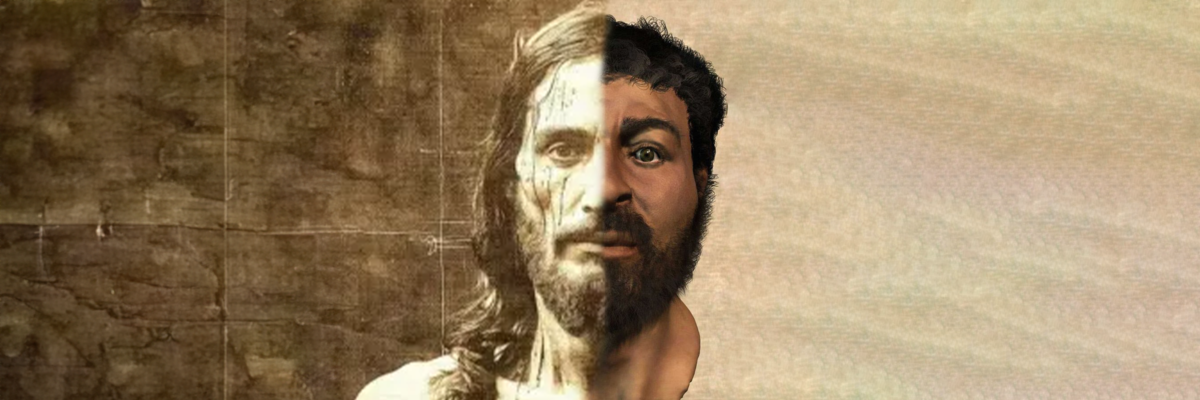
Audio only:
In this episode, Trent rebuts extreme positions on what Jesus looked like and examines the theological implications of that issue.
Transcription:
Trent:
A bunch of news articles have come out recently saying that new research has proven the shroud of Turin is 2000 years old, and so it is Christ’s actual burial shroud and some people have used AI to try to flesh out what Jesus looked like based on the image on the shroud. The image for those of you who are listening by podcast looks a little like Mormon Jesus, but you might also say it looks like the Christ panto crater icon, an early sixth century painting of Jesus. But in today’s episode, I need to talk about people who are getting really weird about what Jesus looked like and I also want to talk about legitimate questions regarding Jesus’s physical appearance that raise theological questions. Before I do that though, I want to say that I am not weighing in on whether the shroud of Turin is authentic or not and so that this is or definitely is not an image of Jesus Christ that would require a very long episode of its own and people are free to accept or not accept the authenticity of the shroud.
I would however, caution people to not be overly confident in the latest research. You don’t want to overplay your evidence. This research is based on wide angle x-ray scattering technology and that technology to use for dating is really new. It’s only been cited a handful of times prior to this paper. Moreover, the study gets a date of 2000 years old in the shroud by assuming that the shroud of Turin stayed between 68 and 72 degrees and 55 and 75% humidity for 2000 years, which is a pretty big assumption. So that’s just my caveat about this new shroud research. But what I find more worrying is people who get so attached to this image of Christ that they end up saying really awful things. Here’s a post that got nearly 2 million views on X. Remember when British forensic experts and Israeli archeologists claim that Jesus was this hideous brown guy?
Now that the shroud of tur has been confirmed, authentic AI has been used to determine what Jesus actually looked like and it matches how he was always depicted. Another popular post says that the earliest eyewitness accounts of Jesus say that Jesus looked like the typical long hair, blue eyed, amazing cheekbones Jesus, and it cites an ancient source publius lentils as confirming this. Alright, so here’s what’s wrong with these memes. First, the image on the left that he calls the ugly brown guy. This image never tried to represent Jesus Christ. In 2001, the forensic anthropologist Richard Neve created a model of a Galilean man, just a random Galilean man from the first century for the BBC documentary Son of God, and he did so working on the basis of an actual skull that was found in the region as noted in this clip from the BBC. Now on
CLIP:
The left of your screen, you’ll see the traditional depiction that we have of him in a church’s stained glass window with long hair and a beard, but on the right is a reconstruction of a 2000 year old skull of a man from the Galilee area.
Trent:
The point was that this is what the average man in Jesus’ time probably looked like, which makes it reasonable to believe that Jesus probably looks something like this. Since the prophet Isaiah said the following of the Messiah, he had no form or comeliness that we should look at him and no beauty that we should desire him. On a side note, this description also applies to Jesus’ height. If the average height of men in Jesus’ time was five foot five, then it’s possible the man in the shroud could be Jesus because the man in the shroud’s height has been estimated to be between five seven and six foot two. If he was five seven, Jesus would’ve been slightly taller than average, but other sources say the average height of men in Jesus’ time was five foot one, which calls into question the shroud being an authentic image of Jesus.
Sense of that was how tall people were in Jesus’ time and Jesus was six to 13 inches taller. Based on the shroud estimates, Jesus would’ve been considered a giant king. Saul was noted in scripture for being a head taller than every other man, and if Jesus were so freakishly tall, Judas is scary. It would not have needed to identify him with a kiss in the garden of Gethsemane. He could have told the guards to seek out the really tall guy. Second, the claim that the alleged earliest sources always describe Jesus as looking like AI Jesus. Well, they’re based on forgeries. The meme, for example, cites the letter of lentils, which claims to be from the governor of the jerusalemites addressed to the Roman Senate and people it says of Jesus, his hair is of the color of the ripe hazelnut straight down to the ears, and it is parted in two on the top of the head and his eyes are blue, gray and bright, but there’s no evidence lentils existed and the letter first appears in the historical record in the 15th century after Christ.
The Catholic encyclopedia written in 1912 says The following, the letter of lentils is certainly apocryphal. There never was a governor of Jerusalem. No procurator of Judea is known to have been called lentils. A Roman governor would not have addressed the Senate, but the emperor, a Roman writer, would not have employed the expressions prophet of truth, sons of men, Jesus Christ. Instead, the earliest depictions of Jesus make him look very Roman, especially by having no beard. This can be seen in a house church from the third century and a catacomb from the third century. Over time, depictions of Jesus begin to change and reflect the cultures in which the art was created, such as by giving Jesus a beard. Since we don’t have a divinely revealed answer to the question, what did Jesus look like? Artists are free to depict Jesus in different ways, including by having him belong to other races like being Asian.
In doing this, artists show that God became man as part of a universal mission to redeem all of mankind, which refers to all human beings of every race and ethnicity. Artists can take this liberty in portraying holy people because God himself takes some liberties in how holy people appear. Luke 24 describes how the disciples on the road to Emmaus where kept from recognizing Jesus, which may mean Jesus looked different from their perspective. Marian apparitions like our Lady of Guadalupe la Ette and Akita among others often involve the Sr beholding Mary looking different in accord with the different cultures of the seer. Sears who receive private revelation also differ in whether they see Christ being crucified with one nail going through both of his feet or two nails going through each of his feet. Pope Benedict 14th wrote a book in the 18th century about beatification and canonization of servants of God called heroic virtue.
In the third volume, the Pope talks about how Sears might see different numbers of nails or they might have visions of St. Jerome with a lion as a companion. Even though that is a later legend and not historical, the Pope says that raptures may be above nature and in their substance divine, but in their circumstances conformed to the ideas naturally received, which God leaves in the state they are in. He gave the example of the blessed Claire of Monte Falco’s vision of Christ’s nails, and he wrote the following, will you decide that the crucifixion was so because that holy woman’s meditations on the crucifixion assumed that form? I think nod if you have common sense. These instruments were engraving on her heart not to delineate the passion of Christ, but to make known to posterity. The fervent love of Claire private revelation and relics aren’t meant to reveal mysteries about God to the whole world.
That is what public revelation is for the catechism says of private revelation. It is not their role to improve or complete Christ definitive revelation, but to help live more fully by it in a certain period of history. Private revelation is a way to see our own relationship with God more clearly and to grow in holiness by emulating the saints who were blessed with these visions or who safeguarded these relics. So let’s keep that at the focus when we meditate on something as awe inspiring as the appearance of the incarnate God, man, Jesus Christ, thank you so much for watching and I hope you have a very blessed a day.



